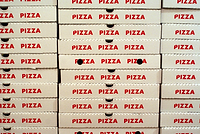Battle of the Birds: How to Keep Birds Out of Restaurants and Food Production Facilities

The Trouble with Birds
Simply put, birds of all feathers need to be kept out of restaurants and food manufacturing areas for a variety of reasons. Not only do they transmit diseases, they’re not exactly the cleanest creatures—even if they do use a birdbath from time to time.
What makes birds especially dangerous is that they often travel great distances, meaning they have the ability to spread contagion rapidly. Fowl also harbor over 40 types of parasites and host over 60 types of infectious diseases. If that’s not enough to make your stomach turn, there’s more.
If birds nest nearby, they can spread illness and disease via their feces, which can literally drop from anywhere at any time. Consequently, the effect they can have on a foodservice plant or a restaurant can be devastating. The diseases that live within the parasites of these animals make them particularly susceptible to passing on infection to humans and contaminating stored food sources.
Dropping In On New York
When a bird defecates into human food or a water source, it can create a veritable health crisis. In the summer of 1993, New York City residents faced water quality problems when unhealthy Escherichia coli bacteria infiltrated drinking water in parts of the city. For several days, environmental officials were baffled by the outbreak and brought in microbiologists to help identify the source of the problem. While a firm conclusion was never reached, strong circumstantial evidence pointed to seagull droppings infecting a Yonkers water supply.[1] The contamination ultimately led to the development of additional protections to ensure the future purity of the city’s water supply.
Note that, aside from direct contamination like the one experienced in New York, airborne spores from drying bird feces in locations like air ducts or vents can also settle on exposed food and create chaos.
Cleanup Precautions
When bird fecal dust is inhaled, the warm and moist environment of the human lung allows the infectious agents to breed. This is why one must always wear protective attire, a respirator and goggles when cleaning bird sites. Even seemingly mild things like a small cut can create infection since it is possible that the object one cut oneself on was covered in bird fecal dust.
And, since winged creatures carry parasites—mites, fleas and ticks—they can spread plague, encephalitis, pox and meningitis. Hence, proper bird control also means a parasite extermination plan.
Other Factors to Consider
Aside from the various health risks posed by birds, restaurant and food plant inventories that are covered and contained can still be damaged by bird droppings due to its very acidic chemical composition. Think about the effect bird droppings have on your car if not cleaned off. Meanwhile, droppings and nests pose cosmetic problems, too, since they are very unattractive on restaurant buildings and corporate plant locations.
So, how do you stay on top of your bird pest problem to make sure your food entertainment enterprise or production plant is free from harmful, bird-produced problems? Step one is creating company protocols and procedures.
Developing Your Plan
First of all, you must hold and document safety trainings for employees that work in your food plant, or for all managers of a restaurant.
The content covered in the trainings should include the following:
- A review of the pest management program
- Vulnerable areas to watch
- Practices that might help eliminate birds
- The review of audits and monthly reports
- The methods needed to record a pest siting
- An overview of federal, state, provincial, local and third-party audits and inspections
- Training regarding how to interact with bird removal tools and devices
Also, staff should be trained to watch out for flying pests and document any sightings. Plant security, restaurant mechanics, production staff, warehousing personnel, quality assurance members and others can be a part of this training.
If any portion of the company plan to combat these creatures is outsourced, the work must be performed by a pest management service that conforms to the U.S. Food and Drug Administration’s current Good Manufacturing Practices.[2]
Additionally, your plant or restaurant must provide a summary of any pest observations and potential problem areas to your management team. Infestation observations should be based on both sightings and droppings. Once installed, all pest management devices need to be mapped and recorded.
Prior to implementing the management program, a company must be sure to review all available bird pest history information. This information should include sightings, trends and any previous management processes that have been used. This historical information is important because a proper eradication strategy can only be professionally completed when viewed in the context of the bigger picture.
Be sure to note any areas of the business where food materials are exposed, and any potential entry points for birdlife, including doors or vents on the building exterior.
Ongoing Procedures
Your plan also will need to identify how long you’re willing to wait before seeing results. If the problems related to your airborne pests do not subside in a timely manner, you might have to greatly increase your efforts.
Any bird eradication devices should have important information such as any service verification stickers, cards or product barcodes in case these data ever needs to be reviewed by an objective set of eyes. A master map of all control devices used on the property should be maintained and kept current. Any dead fowl will need to be deposited off site. Employees that remove carcasses will need to wear the appropriate protective gear.
Follow Up Protocols
Inspections will need to be conducted—at a minimum—monthly. Sometimes mechanical alterations on the exterior of the building will be required. These building changes will need to be approved by an authorized plant or restaurant contact. Often, wires and nets can be used to combat the threat.
Yearly, a supervisor, quality assurance staff person or a manger should objectively review the plant or restaurant program. Any labels or safety data sheets should also be studied.
If you’re comfortable with the training your employees have received, you might want to include them in the annual review of the restaurant or plant. This study should include an inspection of the exterior property and interior of the plant, a summary of bird infestations, what areas are susceptible to contamination and an analysis of all seasonal trend data. Any quality assurance audits should also be looked at.
Record Keeping
Also, be sure that all documents related to your plan are electronically retained. All service tickets should also be kept electronically. Documentation of sightings should include the area affected, the type of bird, the date, time and what shift the fowl was sighted on.
You will also need to keep a sighting log. The log will not only include the information above but will note what action was taken by the restaurant or plant to remove the problem.
Keeping your plant or restaurant free of birds will be hard work. But the plans and protocols you develop will keep you, your staff and your customers free from all forms of bird menace contagion.
Kelly A. Nelson is the content marketing director at Bird-X, Inc.
References
- http://www.nytimes.com/1993/08/04/us/sea-gulls-in-yonkers-are-suspects-in-water-contamination-mystery.html.
- http://www.fda.gov/food/guidanceregulation/cgmp/.
Looking for a reprint of this article?
From high-res PDFs to custom plaques, order your copy today!





